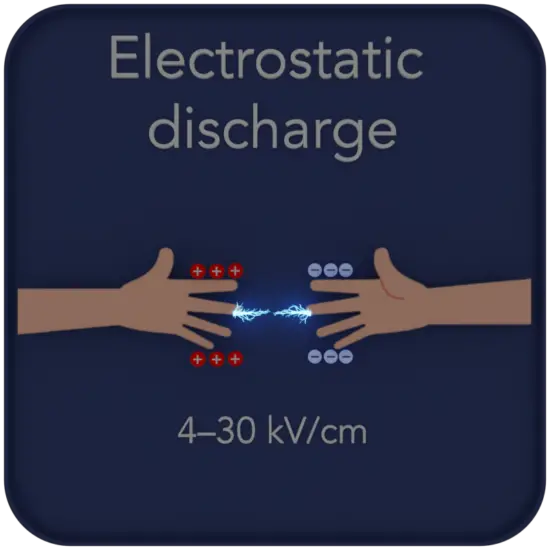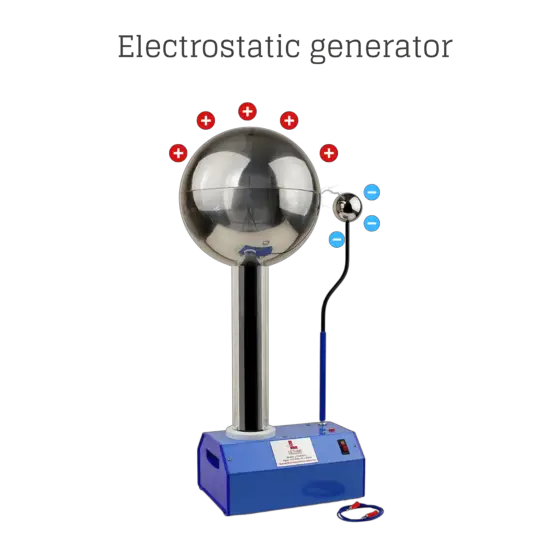30-second summary
Static Electricity and Electricity
Static electricity is an informal term for phenomena caused by the accumulation of electric charge on the surface of various bodies and objects and their exchange in contact with each other.
The electric potential difference (i.e. voltage) can be generated using either of two mechanisms: electrostatic induction or the triboelectric effect.
Such generators generated very high voltage and low current. Because of their inefficiency and the difficulty of insulating machines that produced very high voltages, electrostatic generators had low power ratings and were never used for generation of commercially significant quantities of electric power. Their only practical applications were to power early X-ray tubes and later in some atomic particle accelerators.

Static Electricity
Static electricity is an informal term for phenomena caused by the accumulation of electric charge on the surface of various bodies and objects and their exchange in contact with each other.
Most of the static electricity we encounter every day is caused by the triboelectric effect. The triboelectric effect is a type of contact electrification in which certain materials become electrically charged after they come into contact with one another and then separated.
The friction of the two materials greatly increases the effect due to the frequent contact and separation of these materials. On dry days, static electricity is much more noticeable since the air contains fewer water molecules to allow leakage.
Note that a very high voltage is required to generate every 1mm of an electric arc. Air is a very bad conductor of electricity and has high dielectric strength. The dielectric strength of air is nearly 3000V/mm. Under severe conditions, up to 15 000 Volts have been recorded. It is quite common to experience 5 000V. In fact, many people do not feel a shock from a static electricity discharge of less than about 2 000-4 000V. The main reason that shock caused by static electricity does not hurt anybody is its very low amperage.
Electrostatic Generator

An electrostatic generator is an electrical generator that produces static electricity, or electricity at high voltage and low continuous current. The electric potential difference (i.e. voltage) can be generated using either of two mechanisms: electrostatic induction or the triboelectric effect.
Such generators generated very high voltage and low current. Because of their inefficiency and the difficulty of insulating machines that produced very high voltages, electrostatic generators had low power ratings and were never used for generation of commercially significant quantities of electric power. Their only practical applications were to power early X-ray tubes and later in some atomic particle accelerators.
There are different types of electrostatic generators (ESG’s); they can be friction or induction generators. ESG creates high voltage but has very low current. The voltages can go easily up to a hundred thousand voltages, but the current will only be of a few hundred microamperes. Dielectric materials can increase the breakthrough voltage and produce more electrical energy.
- Wimshurst machine,
- van de Graaff generator,
- Rotating-Disc High Voltage Generator.
Wimshurst machine
Wimshurst machines use an electrostatic induction effect to create electrical energy. These machines belong to a class of electrostatic generators called influence machines, which separate electric charges through electrostatic induction, or influence, not depending on friction for their operation. It has two dielectric plates with multiple metal blades. A two-ended brush is connected to each plate, and both plates are connected to their own conductor. When the plates are spinning in the opposite direction, the Wimshurst machine starts to collect positive charge on one side of the conductor and negative charge on the other side. It continues until the conductors are enough charged, and voltage will breakthrough between conductors. When the voltage breakthrough occurs, the charging process starts again if the plates are moving.
Van de Graaff generator
A Van de Graaff generator (VDG) is an electrostatic device capable of producing very high voltages while maintaining a smaller, constant current. The first Van de Graaff generator was built in 1929 by Robert J. Van de Graaff, the American physicist, and inventor. It uses a moving belt to accumulate electric charge on a hollow metal globe on the top of an insulated column, creating very high electric potentials.
A simple Van de Graaff generator consists of a belt of rubber (or a similar flexible dielectric material) moving over two rollers of differing material, one of which is surrounded by a hollow metal sphere. A comb-shaped metal electrode with sharp points is positioned near each roller. The upper comb is connected to the sphere and the lower one to the ground. When a motor is used to drive the belt, the triboelectric effect causes the transfer of electrons from the dissimilar materials of the belt and the two rollers. As can be seen in the figure, the rubber of the belt will become negatively charged while the acrylic glass of the upper roller will become positively charged. The belt carries away a negative charge on its inner surface while the upper roller accumulates a positive charge.
The potential difference achieved by modern Van de Graaff generators can be as much as 5 megavolts. The Van de Graaff generator was originally developed as a particle accelerator for physics research, as its high potential can be used to accelerate subatomic particles to great speeds in an evacuated tube. Aside from its use in educating physics students about the properties of electrostatics, the Van de Graaff generator has been most frequently implemented as a power supply for particle accelerators. Van de Graaff-powered x-ray machines have been used for imaging and medical treatment.
Rotating-Disc High Voltage Generator
Rotating-disc high voltage generator uses induction instead of the friction method. The electric charge will be transported from the ground potential to the HV terminal by charge carriers, which rotate in the insulators disk. Charge carriers make electrical contact through the inductors’ electrodes. The inductor does not move and they are located in an outer ring.
Other methods of producing voltage
The voltage, or the electric potential, can be produced by the following methods:
- Static electricity – Most of the static electricity we encounter every day is caused by the triboelectric effect. The charging of a solid object by rubbing can be explained by the transfer of electrons from one object to the other. This can easily be produced by rubbing two dissimilar materials together, such as rubbing amber with fur or glass with silk.
- Electrochemistry – Chemicals can be combined with certain metals to cause a chemical reaction that will transfer electrons to produce electrical energy.
- Magnetic induction – Rotating coils of wire through a stationary magnetic field or by rotating a magnetic field through a stationary coil of wire produces an electric potential.
- Piezoelectric effect – Bending or twisting certain materials will cause electrons to drive out of orbit in the direction of the force. When the force is released, the electrons return to their original orbit.
- Thermoelectricity – Heating two joined dissimilar materials will cause a transfer of electrons between the materials setting up a current flow.
- Photoelectric effect – The photoelectric effect is the emission of photoelectrons from a material matter when electromagnetic radiation (photons) hits its surface.
- Thermionic emission – Freeing electrons from a hot surface causes electrons to escape.
Frequently asked questions
Most of the static electricity we encounter every day is caused by the triboelectric effect. This can easily be produced by rubbing two dissimilar materials together, such as rubbing amber with fur or glass with silk. The friction of the two dissimilar materials greatly increases the effect due to the frequent contact and separation of these materials.
It is quite common to experience 5 000V. In fact, many people do not feel a shock from a static electricity discharge of less than about 2 000-4 000V. The main reason that shock caused by static electricity does not hurt anybody is its very low amperage.
There are different types of electrostatic generators (ESG’s); they can be friction or induction generators.
Wimshurst machine,
van de Graaff generator,
Rotating-Disc High Voltage Generator.



